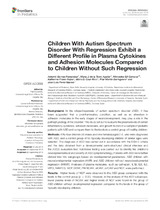Children With Autism Spectrum Disorder With Regression Exhibit a Different Profile in Plasma Cytokines and Adhesion Molecules Compared to Children Without Such Regression
Autor
Gómez Fernández, Antonio Rafael
Torre‑Aguilar, M. J. de la
Gil Campos, Mercedes
Flores Rojas, Katherine Ubina
Cruz-Rico, María D.
Martín-Borreguero, Pilar
Pérez Navero, Juan Luis
Editor
FrontiersFecha
2018Materia
Autism spectrum disorderCell adhesion molecules
Children
Cytokines
Neurodevelopmental regression
METS:
Mostrar el registro METSPREMIS:
Mostrar el registro PREMISMetadatos
Mostrar el registro completo del ítemResumen
Methods: Fifty-four children (45 males and nine females) aged 2-6, who were diagnosed with ASD, and a control group of 54 typically-developing children of similar ages were selected. The diagnosis of ASD was carried out in accordance with the DSM-5 criteria and the data obtained from a developmental semi-structured clinical interview and the ADOS evaluation test. Additional testing was carried out to identify the children's developmental level and severity of ASD symptomatology. Patients with ASD were further divided into two subgroups based on developmental parameters: ASD children with neurodevelopmental regression (AMR) and ASD children without neurodevelopmental regression (ANMR). Analyses of plasma molecules, such as cathepsin, IL1β, IL6, IL8, MPO, RANTES, MCP, BDNF, PAI NCAM, sICAM, sVCAM and NGF, were performed.
Results: Higher levels of NGF were observed in the ASD group compared with the levels in the control group (p < 0.05). However, in the analysis of the ASD subgroups, lower plasma levels of NCAM and higher levels of NGF were found in the group of ASD children without developmental regression compared to the levels in the group of typically-developing children.
Conclusions: These results suggest differences that could be related to different pathophysiological mechanisms in ASD. There is not a specific profile for the expression of relevant plasma cytokines, adhesion molecules or growth factors in children with ASD compared with that in typically-developing children. However, in the ANMR and AMR subgroups, some of the adhesion molecules and neuronal growth factors show differences that may be related to synaptogenesis.

